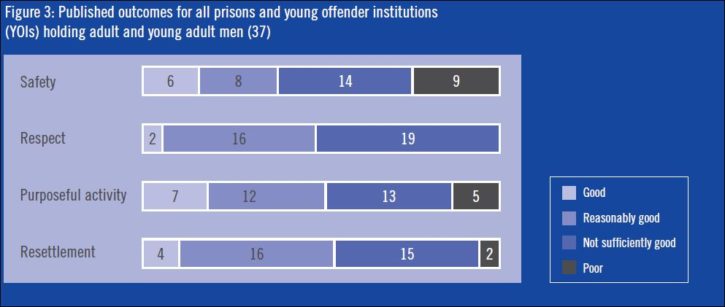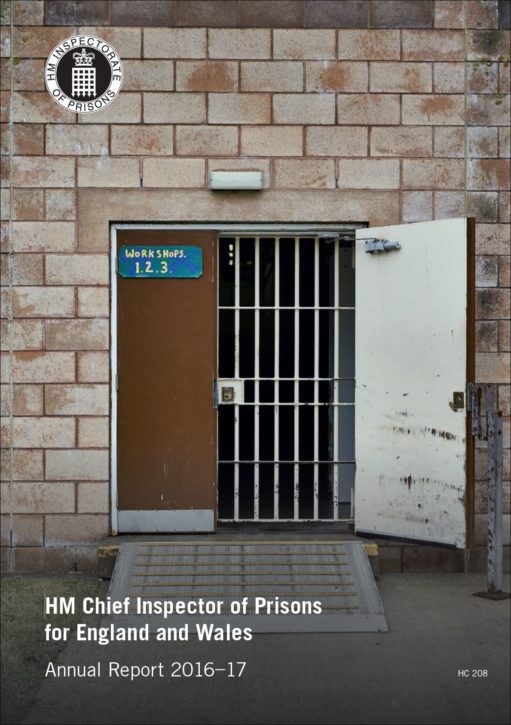Chief Inspector highlights prison safety in annual report
Prison reform will not succeed unless the violence and prevalence of drugs in jail are addressed and prisoners are unlocked for more of the working day.
That is the main conclusion of the Chief Inspector of Prisons, Peter Clarke as he published his annual report today (18 July 2017) based on 86 individual inspection reports on prisons, police custody suites, immigration removal centres and other custodial establishments.
Ministry of Justice (MoJ) data showed that:
- in the 12 months to December 2016, there were more than 26,000 assaults, an increase of 27%;
- during the same period, assaults on staff rose by 38% to 6,844 incidents;
- of these assaults on staff, 789 were serious, an increase of 26%; and
- the number of self-inflicted deaths has more than doubled since 2013 and in the 12 months to March 2017, 113 prisoners took their own lives.
Three quarters of inspected prisons sub-standard
Of the 29 local and training prisons inspected during the year, inspectors judged 21 of them to be ‘poor’ or ‘not sufficiently good’ in the area of safety.
Peter Clarke said:
Why have so many of our jails become unsafe? Many of the reasons have been well documented. The prevalence of drugs inside prisons and the seeming inability to keep them out has been a major factor. Debt, bullying and self-segregation by prisoners looking to escape the violence generated by the drugs trade are commonplace. This has all been compounded by staffing levels in many jails that are simply too low to keep order and run a decent regime that allows prisoners to be let out of their cells to get to training and education and have access to basic facilities.
What is it like for prisoners on a day-to-day basis? I have often been appalled by the conditions in which we hold many prisoners. Far too often I have seen men sharing a cell in which they are locked up for as much as 23 hours a day, in which they are required to eat all their meals, and in which there is an unscreened lavatory. On several occasions prisoners have pointed out insect and vermin infestations to me. In many prisons I have seen shower and lavatory facilities that are filthy and dilapidated but with no credible or affordable plans for refurbishment. I have seen many prisoners who are obviously under the influence of drugs.
Particular concerns for young people and children
Some of the most concerning findings during the year came from inspections of the custodial estate for children and young people. In the light of revelations last year about apparent mistreatment of children at Medway Secure Training Centre (STC), the Inspectorate maintained the momentum of inspections at STCs and young offender institutions (YOIs). At that time there were around 609 children held in YOIs and 155 in STCs.
- Youth Justice Board Annual Statistics for 2015-16 showed self-harm rates at 8.9 incidents per 100 children compared with 4.1 in 2011;
- assault rates were 18.9 per 100 children compared with 9.7 in 2011;
- HMI Prisons’ own surveys showed that 46% of boys felt unsafe at their establishment; and
- the proportion of boys engaged in a job (16%), vocational training (11%) and offending behaviour programmes (16%) across the YOIs was lower in 2015-16 than at any point since 2010-11.

Peter Clarke said:
In early 2017 I felt compelled to bring to the attention of ministers my serious concern about our findings in the youth estate. By February 2017, we concluded that there was not a single establishment that we inspected in England and Wales in which it was safe to hold children and young people.
The speed of decline has been staggering. In 2013-14 we found that nine out of 12 institutions were graded as good or reasonably good for safety. The reasons for this slump in standards are no doubt complex, but need to be understood and addressed as a matter of urgency.
There seems to be something of a vicious circle. Violence leads to a restrictive regime and security measures which in turn frustrate those being held there. We have seen regimes were boys take every meal alone in their cell, where they are locked up for excessive amounts of time, where they do not get enough exercise, education or training, and where there do not appear to be any credible plans to break the cycle of violence.
Other findings
Other key findings from the report include:
- outcomes for prisoners in the five women’s prisons inspected in 2016-17 were better, with strong outcomes for safety, respect and resettlement, although the incidence of self-inflicted death and self-harm among women has risen dramatically;
- new psychoactive substances were beginning to have an impact within immigration detention as well as the custodial estate;
- there had been some improvements in the Rule 35 process, designed to protect those with serious health problems or who had been victims of torture;
- despite police custody being considerably professionalised in recent years, there needs to be a continuing focus on safety, with still too many deficiencies in the governance of the use of force.
Conclusion
Inspectors found – for the first time – that the number of recommendations that had been fully achieved was lower than the number not achieved. The Chief Inspector expressed his dismay in strong terms:
In many cases the response to previous recommendations has been unforgivably poor.
Given the predictably shocking findings of this annual report, it is perhaps no wonder that the government has abandoned the Prisons and Courts Bill which would have given prison inspectors new powers and required the Justice Secretary to respond to an “urgent notification” of concerns about a particular prison within 28 days setting out:
the actions that the Secretary of State has taken, or proposes to take, in response to the concerns described in the notification.
All prison posts are kindly sponsored by Prison Consultants Limited who offer a complete service from arrest to release for anyone facing prison and their family. Prison Consultants have no editorial influence on the contents of this site.









